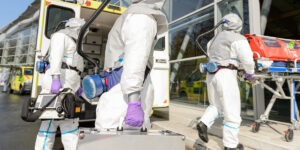

Enhancing Zones to Protect the Emergency Responder
Glen Rudner
March 20, 2013
The top priority of the responders who are called to a fire or other incident, of course, is scene safety. To reduce the chances of those responders becoming victims themselves, fire departments should communicate and work closely with law enforcement agencies to better understand the perimeters and resources that the law enforcement community uses to protect responders.

Gas Refinery Attack in Algeria: The Lessons Learned (Mobile)
Joseph W. Trindal
March 20, 2013
When the In Amenas Gas Refinery was attacked at the beginning of 2013, the swift actions of workers prevented the terrorists from fully implementing their plans, which would have created a greater tragedy and an even greater loss of lives. A lot can be learned by reviewing the events that unfolded in Algeria and making changes that may save even more lives in the future.

Gas Refinery Attack in Algeria: The Lessons Learned
Joseph W. Trindal
March 20, 2013
When the In Amenas Gas Refinery was attacked at the beginning of 2013, the swift actions of workers prevented the terrorists from fully implementing their plans, which would have created a greater tragedy and an even greater loss of lives. A lot can be learned by reviewing the events that unfolded in Algeria and making changes that may save even more lives in the future.

Improving Officer Safety Through Preparation and Practice
Monica Giovachino
March 19, 2013
Although the Incident Command System (ICS) concept has been available for use since 1968, many law
enforcement agencies are still faced with difficulties implementing ICS each and every time it is needed. When implemented properly, ICS can prevent some officers from dying in the line of duty.

Safer Schools Through Advance Planning
Donald J. Cymrot and Stephen E. Rickman
March 13, 2013
In response to the 14 December 2012 school shootings in Newtown, Connecticut, President Barack Obama has offered a wide range of executive orders and proposals – including several specifically intended

Predictive Policing: Actionable Information About Potential Crimes
Rodrigo (Roddy) Moscoso
March 13, 2013
The most cost-effective way to fight crime may well be to prevent it from happening in the first place. Current predictive software is helping law enforcement agencies combat crime by directing their limited resources to the locations where they will be most useful. However, doing so may raise certain legal concerns in the future.

Unique Dangers Posed by Lone-Wolf Terrorists
Jeffrey D. Simon
March 13, 2013
Members of terrorist organizations such as al-Qaida follow a general, albeit loose, organizational/leadership structure, which includes planning and communicating with other members of their group or cell. The sometimes greater danger posed by lone wolves, on the other hand, is that they are not limited by the views and actions of other members and not as susceptible to having their plans and communications intercepted and disclosed.

Staying Ahead of ‘The Big One’
Joseph Cahill
March 6, 2013
When the average citizen is confronted by an emergency situation beyond the routine, he or she is usually overwhelmed and forced to rely on emergency responders to take command and

Missing in Action: Private-Sector Situational Awareness
Michael J. Pitts
March 6, 2013
Immediately following an incident, the truly “first” responders usually are private citizens. However, the private sector’s responsibilities really begin by: identifying the warning signs, understanding the roles each citizen plays in the four phases of emergency management, and educating and training individual responders.

Police Training for Hazardous Threats
Shannon Arledge
March 6, 2013
Hazardous material threats come in many forms and can be found in any law enforcement jurisdiction. When police officers and other responders encounter such threats their lives and the safety of many others may depend on them knowing what to do and how to do it. Training them, and helping them train others, may significantly reduce the number of casualties in future toxic-agent or biological incidents.

